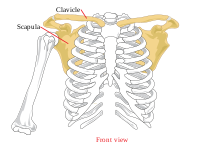
Photo from wikipedia
PurposesDetails concerning the normal growth of the pelvic girdle in the fetus are of importance in the early detection of congenital defects. This study was executed to quantitatively evaluate the… Click to show full abstract
PurposesDetails concerning the normal growth of the pelvic girdle in the fetus are of importance in the early detection of congenital defects. This study was executed to quantitatively evaluate the primary ossification center of the ischium with relation to its linear, planar and volumetric parameters.Materials and methodsUsing methods of CT, digital-image analysis, and statistics, geometrical dimensions of the ischium’s primary ossification center in 42 spontaneously aborted human fetuses (21 ♂ and 21 ♀) aged 18–30 weeks were calculated.ResultsWith no sex and laterality differences, the best fit growth dynamics for the ischium’s primary ossification center were displayed by the following functions: y = − 10.045 + 0.742 × age ± 0.013 (R2 = 0.97) for its vertical diameter, y = − 5.212 + 0.385 × age ± 0.008 (R2 = 0.97) for its sagittal diameter, y = − 36.401 + 0.122 × (age)2 ± 45.534 (R2 = 0.96) for its projection surface area, and y = − 1052.840 + 368.470 × ln(age) ± 12.705 (R2 = 0.91) for its volume.ConclusionsNeither male–female nor right–left differences are found for any of the morphometric parameters of the ischium’s primary ossification center. With relation to fetal ages in weeks, the ischium’s primary ossification center grows proportionately in vertical and sagittal diameters, second-degree polynomially in projection surface area, and logarithmically in volume. The quantitative findings of the ischium’s primary ossification center are considered age-specific reference data of relevance in the diagnostics of innate defects.
Journal Title: Surgical and Radiologic Anatomy
Year Published: 2018
Link to full text (if available)
Share on Social Media: Sign Up to like & get
recommendations!